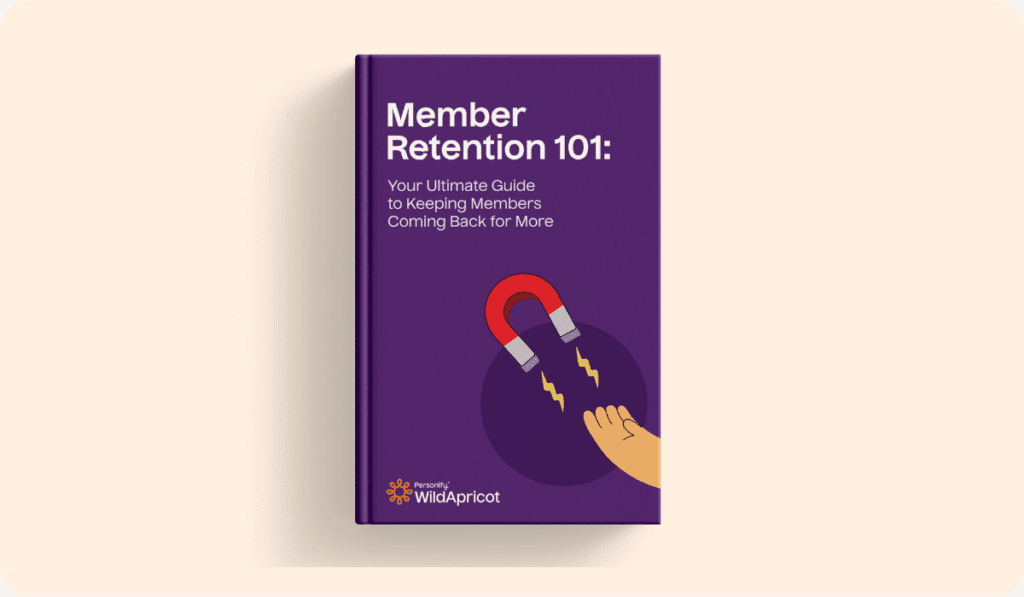Ready to build your membership website? Not sure which platform to use? Don’t worry—even if coding isn’t in your wheelhouse, Webflow is just one of the great website builders that you can use to create your membership site, no technical experience required.
In this post, we’ll walk you through the benefits of a membership site, how to choose the right website builder for you and steps for building in Webflow. If you want to jump right to that section, click here.
What are membership sites?
Membership sites are like bonus content on your website—but for members only. All visitors can explore the public pages on your website. But by signing up and logging in, your members get access to exclusive content designed just for them.
The content on your membership site should give members value aligned with their interests. Through your content, your members can really engage with your organization and get the most value out of their membership.
You can offer resources like industry news, educational resources, training, community forums, newsletters and more.
What are the benefits of a membership based website?
Membership sites are a great place to engage and retain your members, all while allowing you to understand the interests, drives and skills in your community.
Here are just a few of the ways membership based website benefit your organization:
- Be easier to find
- Become known as an industry leader
- Grow your member community
- Create easy-access members-only content
- Advertise events
- Make member management simple
- Gain more revenue
1. Be easier to find
People who are familiar with your organization know that they can go to your website whenever they need a refresher on your mission or activities. In the same way, having a membership site gives your members a central hub they can go to access the resources you’ve created for them.
You might have a few places online where members can engage with you and each other (like social media). But don’t leave them wondering where to find what they’re looking for. A membership site can help avoid confusion and frustration by keeping everything organized in one place.
2. Become known as an industry leader
Having a membership site can give your reputation a boost! By offering your members truly helpful benefits and resources, you can help them succeed with their goals and interests. That’s likely to create a positive buzz and show just how great it is to be part of your organization.
Your members’ wins are your wins. Celebrate them and you might even gain some members who champion your organization, encouraging others to get involved. That’s one way your membership site can become known as a reliable place for personal or professional growth that others will want to join too.
3. Grow your member community
You can use your membership site to foster a sense of community among your members and bring new members on board. You’ll want to make it easy for new members to join as well as for existing members to stay engaged.
For new members:
- Have a clear invitation to join: Let them know how to join and what they can expect.
- Offer flexible options: Having a few different membership tiers can open the door to curious potential members, with the option to upgrade later.
For existing members:
- Engage them regularly: Give them content aligned with their interests and keep your offerings fresh.
- Host forums and events: Let members chat, network, and learn more from one another, as well as your organization.
4. Create easy-access members-only content
You’ve spent time and effort creating resources your audience will love. You can gate that content so it’s available only for members. This high-value content can incentivize others to join too and means you get the most out of the time spent creating it.
Here are examples of content you might include on your membership site:
- Descriptions of membership tiers and benefits
- Resource library full of webinars, guides, templates, and more
- Forum for members to connect with one another
- Events calendar
5. Advertise events
Do more than show your events calendar. If your membership site platform comes with marketing capabilities, you can create registration pages for your events, promote to your members with automated emails, and even post the recording or recap afterwards.
These features make it easier to manage your events, as it lets you capture registrations automatically and then add those members to lists so you can follow up with them directly by email.
6. Make member management simple
Your membership website can also make member management easier for you. The effort you put into setting it up pays off big in the long run. Many of your responsibilities can be automated, freeing you up to add the personalized touch to your member interactions.
A great membership site is like having an extra staff person who can:
- register new members and event attendees
- process monthly dues, donations, and event payments
- update member profiles
- email members with event invites, reminders, and monthly newsletters
- distribute resources like courses, industry reports, and other materials
- act as the contact person when members have questions, or need help
7. Gain more revenue
As part of membership management, your membership site can automatically send renewal reminders and process dues. Beyond that, there are even more ways you can generate revenue that can be managed through your membership site.
Hosting events, delivering high-value content and creating incentives for members to invite others to join are just a few examples. Your site also presents an opportunity to show on-site advertisements from sponsors as a revenue stream.
Plus, automating more of the daily admin work means that your organization can take on more and scale up—have a larger membership base, create more personalized content and, ultimately, bring in more revenue.
How do I choose a membership site builder?
If you have Webflow on your list of options for your website builder, you likely have some criteria in mind when choosing your ideal platform.
Getting more data can help solidify your decision or reveal a better fit! As you explore your options, here are some questions you can ask to guide you:
- What is our budget and timeline?
- What features and functionality do we need?
- What in-house skills and capacity do we have for building our website?
- What kind of support do we need from the platform developers?
Once you have a great sense of your organization’s needs, it’s time to find the right website platform for you. Here are 5 steps you can take:
1. Research
Make a list of website builders you’re interested in using and compare their cost, functionality, ease-of-use and troubleshooting support services. Narrow your list down to your top 3–5 choices.
2. Test it out
Demos and trials give you a chance to put some website builders to the test and see if your top picks ladder up to your expectations. Aim to test about 3 different websites for a good comparison.
3. Get board approval
Once you’ve made your choice, it’s time to get board approval. By this point, you’ll have plenty of data to share with them to back up your decision.
4. Onboard key players
With the go-ahead given, build your task force. Who else needs to be involved in decision-making, the website build itself, and onboarding the whole organization?
5. Create training documents
Now it’s time to bring the rest of your team on board. Your training documents make sure everyone is on the same page, including anyone new who joins your organization.
BONUS – Be mindful of migration
Maybe you’re making this change because you’ve grown out of your existing website. If so, consider how much effort a migration to your new membership platform will be and which potential pitfalls to look out for.
Membership management software or membership site + CMS?
In your research, you might find that you’re presented with two options:
- Using a website management software with a built-in website builder, or
- Using a website builder that integrates with a content management system (CMS)
Webflow fits into that second category.
Both options have their strengths. A big factor in determining which will work for you is the existing platforms you use (whether they will integrate) and the capabilities your organization needs.
Let’s take a closer look at the pros and cons of each:
Membership management software: Pros and cons
Pros
- All features in one place
- No API
- No updates to manage
- No coding required
- Only one provider
- Only one bill
Cons
- Design limitations
- Plug in limitations
Membership site + CMS: Pros and cons
Pros
- Easy, beautiful designs
- Lots of plug ins (customizable to what you need)
- Run by large scale companies
Cons
- Membership sites aren’t their core business
- Scattered functionality
- Managing APIs
- Managing multiple plug ins
- Managing plug in updates
- Plug ins might go out of business
- Different support teams for each
- Paying for both website AND member database
Top 5 membership site platforms to consider (no need to code)
While you may be set on using Webflow to build your membership site, it’s a good idea to know what else is out there. Here are the top 5 coding-free membership site platforms in addition to Webflow for you to consider and compare in your search for the right fit:
WildApricot
An association management software plus website builder. WildApricot is great for small organizations who are ready to automate member management, payments, website, events, and more.
MemberClicks
Automate tasks, boost engagement and generate revenue all in one central platform. MemberClicks equips small associations, chambers of commerce and other member-based organizations with the tools for member management.
WordPress
A popular website builder for ecommerce, blogs, and more. Creating your website is easy with their library of templates, drag-and-drop builder, and thousands of plug ins.
Squarespace
Ideal for ecommerce, business, blogging and promoting your services, Squarespace has a lot of use cases. They offer templates with lots of customization and around-the-clock support services in case you get stuck.
Hubspot
An all-in-one platform with your website builder, CMS, marketing, sales CRM, customer service and operations software all in one place. Hubspot is a powerful tool with analytics built in.
Webflow
Webflow is a website builder that lets you work on an easy to use visual canvas with lots of customization. It comes with marketing capabilities—and it recently released membership management features in beta.
5 steps to create a membership site on Webflow
Ready to build your membership website on Webflow? We’ve got you covered with this step-by-step guide.
1. Plan out your website
Decide on which pages you want to include in your site build, an overall look, feel and structure of your page layout and navigation.
To start, your website will need at least these four pages:
- Homepage: Lets people know what your organization is about.
- Sign up: Describe your membership tiers and how visitors can join. Include a form so they can set up their profile as a member.
- Members only: The page(s) of gated content and community for your members.
- Login: For returning visitors to access the gated content.
2. Choose your template
Now that you have a vision for your website, choose a Webflow template. Starting with a design that resembles the look and feel you want to go for will make editing easier for you—and will save you time.
3. Design in Webflow
When you’re in the builder, hovering over elements of your chosen template (text, images, buttons) will highlight them. From there, you can see all the options available for customization: writing new copy, adding in your own images and logos, adjusting sizes, changing the colors and more.
4. Create your members-only content
On these pages, you’ll host content designed just for your members. Typically on Webflow, you’ll need to choose a compatible plug in that will allow you to gate certain pages and manage your members.
Recently though, Webflow added in membership functionality that’s in beta release. It lets you create tiers, a member portal and exclusive content offerings.
Decide which content offerings are targeted to members at different tiers. You may want to make “freemium” content that requires a sign up but has no cost. That way, visitors can get a sample of the value they can get from upgrading their membership.
5. Add membership functionality
Third-party plug ins can give your Webflow website more functionality that makes interacting with your members easy.
There are plug ins with email marketing tools, surveys and pop ups, push notifications, analytics about site activity and more. We’ll explore these more in the next section.
Membership site functionality to add to Webflow
In the fall of 2021, Webflow announced new capabilities that let you build membership websites natively in the platform. Now there are three pieces of functionality that you can use:
- Manage a user database
- Specify access based on user type
- Offer subscriptions
You may still want other functionality. In that case, you’ll need some plug ins to customize your website with all the features you need. Here are a few that work with Webflow:
- Mailchimp: Email marketing, automation, segmentation, A/B testing
- Hubspot: Create forms and integrate your CRM
- Timekit: Build booking experiences for your members
- Drift: A chatbot for real-time conversations with your site visitors
- Beamer: Notify members of updates and collect feedback
Get started building your Webflow membership site
Now you know how to build your membership site on Webflow—from planning out your website to getting your team onboard, to choosing the templates and plug ins that will give you all the functionality you need.
If you’ve been thinking about launching your membership site, the best thing you can do for your organization is get started. You can always fine tune and you should! As your members engage with your platform they are sure to offer feedback that will help you improve.
Thinking of going with a membership management software instead? Learn more about WildApricot.
For an all in one membership management platform that comes with a website builder, WildApricot has got you covered.
To get started with your free, 60-day trial of WildApricot, simply click here.
You’ll be taken to a registration page where you can enter your account details. Once you click submit, you’ll activate a free 60-day trial of the paid version of WildApricot. This means that you will have all the access to all the functionality that our paid clients receive for 30 days.
Good luck with your membership website!






![The Ultimate Guide to Membership Management Software For Nonprofits [2025 Edition]](https://b2993016.smushcdn.com/2993016/wp-content/uploads/2024/02/Main-Blog-Thumbnails-2025-11-06T180717.949-1024x717.png?lossy=1&strip=1&webp=1)


